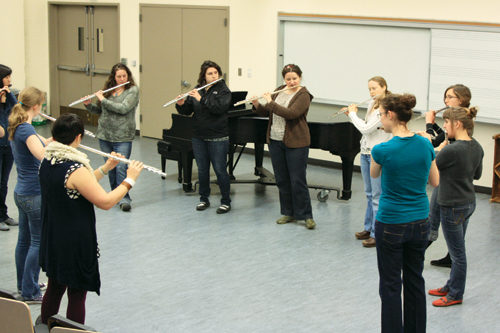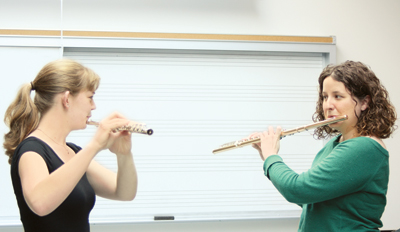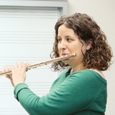
As a graduate student I began experimenting with free improvisation and received encouragement from my teacher, Robert Dick. As I timidly branched out into improvisation, I found a deeper well of creativity, spontaneity, and artistic commitment.
My first attempts at improvisation were with Robert Dick’s simple “Thirty Creative Seconds” exercise, in which the player improvises for 30 seconds using only two notes. The beauty of this exercise lies in the simplicity of the directions, and the eventual knowledge that even within these two notes there is a world of storytelling. I sensed that improvisation had the potential to become a useful tool for finding a new level of focus and creativity. I continued to explore improvisation when enrolled in comedy classes with a local improv troupe. I later adapted the exercises and skills from these classes to the flute.
Comedy improvisation, as seen on television shows like Whose Line Is It Anyway? always looked like an adventure to me. It is fascinating to watch troupes work, building stories together and maintaining an effortless flow with one another. This spontaneity actually requires effort and practice. An entire repertoire of exercises has been created for theatrical, comedic improvisation. Courses in this help players trust one another and themselves, expand the boundaries of expression, and find a spontaneity that comes naturally onstage. As musicians, we can learn from this creative practice.
Comedy troupes offer classes for all levels of improvisers in cities around the country. Many even offer one-day workshops that introduce the basics. If you cannot find a comedic improv class close to you, check out an acting class or a course in theatrical improvisation, as many of the exercises overlap. Most people taking these classes do not have dreams of a comedy or theatrical improv career, but are simply creative people looking to expand their horizons. If you are unable to enroll in a course, there are books and websites about theatrical improv.
Improv classes can be somewhat nerve-wracking at first. I began to realize that many of the main principles of theatrical and comedic improvisation were not only applicable to the stage, but to all areas of life.
The exercises in Patricia Ryan Madsen’s book Improv Wisdom: Don’t Prepare, Just Show Up became a guiding force for my improv class. Many of the exercises that we explored were structured after these basic principles. Here are a few of my favorites:
Don’t (Over) Prepare
As someone who still battles a fair amount of performance anxiety, I sometimes think myself into a corner while performing as I worry about the notes that already have passed. I also worry about difficult passages on the pages ahead. The most crippling effect of all of the worry is that I spend no time focusing on the music I am playing and that should be flowing through me. This is what I am attempting to communicate with the audience. The principle of don’t prepare does not mean don’t practice, it means simply to not dwell on thoughts and worries of the past or future. To over prepare is to deny the spontaneity and joy of the moment. Working with improvisational exercises helps musicians be more attentive to the present. You have spent time practicing and learning the music carefully. To not be open to enjoying and sharing the performance can feel like a real disappointment, both to listeners and the performer.
Make Mistakes
In your practice, take risks. Play with intention. If you make mistakes, make them with flair. Madsen writes, “When I say, ‘Make mistakes, please,’ what I really want is for you to do something risky or challenging, something out of your comfort zone, where mistakes are possible (and likely), and to proceed boldly.” Embrace the mistakes. Whether or not they lead you to new ideas for expression (more vibrato here, a new way of phrasing, or a different tone color there) or just point out a soft spot in your physical connection to the instrument, they are always instructive.
William Westney’s book The Perfect Wrong Note: Learning to Trust Your Musical Self devotes an entire chapter to the “Juicy Mistake.” He states that, through ignoring mistakes, through “over-controlling the body” in an attempt to suppress them, or through simply explaining them away, we stifle the creative process. For your practice sessions, find an environment where you feel comfortable making mistakes. This will help you find a more effortless and artistic flow in your performances.
The End Result
The benefit of comedic improvisational classes, has been enormous. I began to focus on how to use creative improvisational exercises in my practice as well as with my students. I eventually developed a series of group workshops that transferred theatrical improv exercises into musical improv games. Some exercises are corny and fun. While many of the exercises serve as icebreakers, others directly lead to musical improvement and exploration. Musicians Jeffrey Agrell and Tom Hall have also produced excellent, innovative collections of musical improvistation games. Many of the solo and group games I adapted are based on Viola Spolin’s book Improvisation for the Theater.
Solo Improvisation Exercises
In addition to Robert Dick’s Thirty Creative Seconds, I ask students to explore a techinque called Magnification, that is adapted from Spolin’s theatrical exercise. The flutist plays a passage several times. It may be improvised or from the flute repertoire. With each repeated play, he increases the intensity of emotion. As an acting exercise, the emotions might run from affection to love to adoration; suspicion to fear to terror; or irritation to anger to rage. It is easier to portray these emotions verbally, but when students try to change the mood of the music, it changes how they think about the passage and gives new insight and intention in their performance.
Creating improvised passages of varying intensities, moods, colors, and shapes is a great way to expand the boundaries of expression. For some people envisioning a color progression or a set of images is helpful. Can a listener objectively hear that you imagined a passage with an inflection of pink and a dash of light blue in the middle? No, but it might give you (or your students) new ideas and paths of musical exploration.
A teacher friend developed a game in which she writes scenarios, moods, or characters on a few scraps of paper that she folds and places on the stand. The student chooses one and performs a phrase from his repertoire in the selected style. The process repeats, with the student portraying these various styles, until all of the selections have been explored. While the student performs, the teacher tries to guess which interpretation the student is performing. This exercise is especially effective with intermediate level students, as it is engaging and gets the student to think more creatively.
Spolin’s Mirror Sound exercise may also be adapted for the flute studio. Either the teacher or the student begins by improvising anything from one note to a short passage. Then the other flutist responds mirroring the passage back, matching pitch, vibrato, color, dynamics and emotion. Optimally, this should be done almost simultaneously, with the mirroring partner following immediately after the creator has finished. For younger students this exercise might be adapted as an ear training exercise with the creator playing one note and the mirroring partner finding that pitch.

Practicing improvisationally is a technique that both Robert Dick and Wissam Boustany teach. In your practice, take a section of a work and improvise in the same character as that passage. If you are working with a pianist for a recital or are preparing for a chamber music performance, you might convince your cohorts to try it with you.
Group Exercises
Echoing is a group improv exercise that I adapted from Spolin’s book. The group stands in a circle. The first musician plays a note and then one by one the note is played by the next person in the circle. Each player’s goal is to match the intensity of vibrato, tone color, pitch, dynamic level, intensity and emotion of the note before. Echoing sometimes works like a game of telephone, as the sound that starts around the circle changes. A variation of this exercise is to have each player slightly change the note in some way as it is passed around the circle. As the group becomes more proficient, the passing of one note may evolve into passing a phrase. Echoing is based on the comedic improv game Pass the Action, which is a physical version of telephone. In Pass the Action the participants pass a gesture (a bunny hop, a tip of the hat, a strange facial expression) around the room. This is a great game to play without instruments with a group of students to enliven the atmosphere if they are low on energy.
Musical Machine is a fun rhythmic improvisation game. One person creates an idea for a machine, and then the groups acts it out. Each person chooses a sound to represent his mechanical task to make the machine work. The musical machine might build singing mechanical frogs. Ask students to imagine what musical sounds could represent the processes for building such a creature. Players perform their musical tasks in a line, and learn to listen carefully to come in at their cue. The game is goofy, but encourages good listening skills. Fun variations include a slow-motion musical machine, or a musical machine operating at hyper speed.

A more straightforward improvisatory group game is based on Paint Your Mammoth, a flute ensemble composition by Robert Dick. Three small groups participate: one group serves as a drone, one is rhythmic accompaniment, and the third is the melodic component. The drones select a tonality or specific small set of pitches and provide harmonic accompaniment. The rhythm section keeps pace through key clicks, tongue pizzicato (or other percussive flute sounds), clapping, or snapping. The melody group can either use a pre-written melody or improvise within the chosen tonality. This exercise can be a bit more complex than some of the others, but it is a great way to introduce the idea of form in improvisation. When trying this with students, assign one group to be the leader of momentum – perhaps for one turn, the rhythmic component driving the motion of a piece, and deciding when to ramp up the energy to a peak and when to end. On the next turn, the leadership role shifts to the harmonizers, and so on. Give the leading group a time frame to work within to help the students think about how to structure and lead the improvisation.
Improvisation is a tool that helps musicians find greater nuance in our playing. It teaches us to take risks, embrace the moment and run with it. Finding the wonderful improviser that lives within can help to silence the negative, judgmental ghosts that so often plague musicians. None of us are perfect performers, but the world of creative improvisation serves as a useful method for uncovering the playful, artistic spirit that makes for the most inspirational performances.






